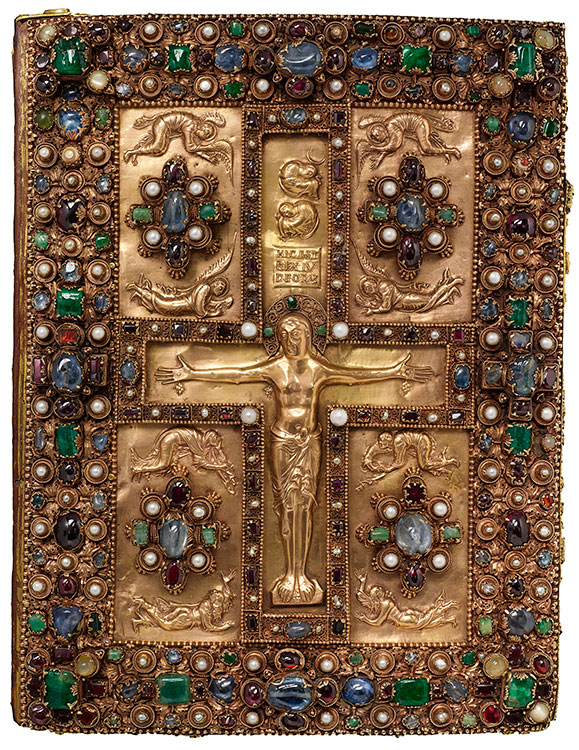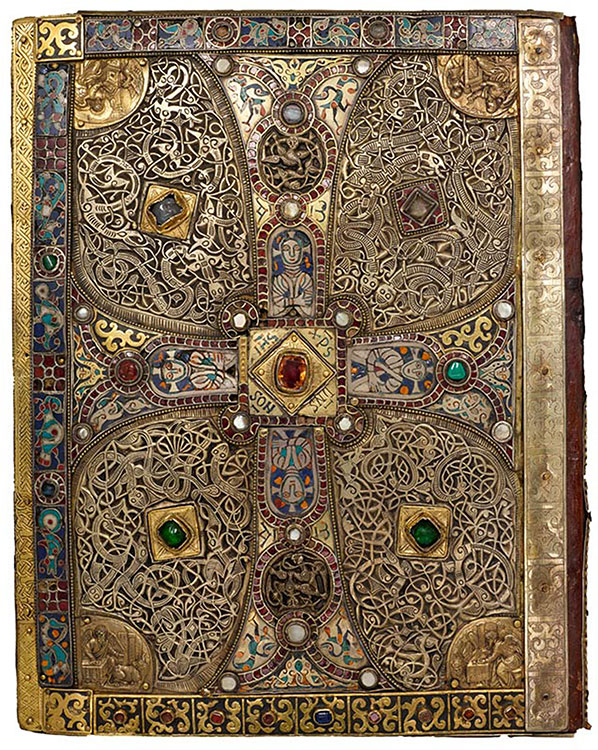BOOK AS TREASURE
This treasure binding is a composite made of two distinct covers brought together on a Gospel book written and illuminated toward the end of the tenure of Hartmut, abbot of St. Gall, likely for ceremonial use in the abbey church. The jeweled front cover must have been a royal gift of immense importance. It is one of only three surviving examples of metalwork that can be attributed to the court workshop of Emperor Charles the Bald (823–877), who, like his grandfather Charlemagne, was a great patron of illuminated manuscripts. The back cover may have once belonged to a Gospel book commissioned by Charlemagne’s rival Tassilo III (ca. 741–796), Duke of Bavaria. Also, the rare Byzantine and Syrian silks lining the inside covers were likely gifts. Because Carolingians lacked the technology to produce silk, such textiles were highly coveted luxury items, often distributed through royal networks.
"Lindau Gospels," in Latin
Switzerland, St. Gall, ca. 880 (manuscript)
Eastern France, ca. 870 (front cover)
Austria, Salzburg region, ca. 780–800 (back cover)
The Morgan Library & Museum, MS M.1
Purchased by J. Pierpont Morgan, 1901
Joshua O'Driscoll, Assistant Curator of Medieval and Renaissance Manuscripts
This magnificent gospel book was written and illuminated in the late ninth century, at the monastery of St. Gall, which is strategically located along one of the alpine passes leading to Italy. The spectacular front and back covers of the manuscript were made elsewhere and predate the book itself.
The golden front cover is a masterpiece of Carolingian metalwork. The figure of Christ on the cross dominates the center of the composition, around which ten figures are arranged in dramatic poses of grief. Directly above Christ, personifications of the sun and moon mourn his death, as do the Virgin Mary and John the Evangelist beneath the cross.
The back cover is no less remarkable. Created for a now-lost luxury gospel book, the cover was made in or around Salzburg about a hundred years earlier than the manuscript it now adorns. Its design consists of a large cross with flared arms, set inside a rectangular enamel frame. Certain details lend the cover a cosmological dimension. The Greek letters alpha and omega are inscribed on the vertical arm of the cross and refer to the beginning and end of time. Likewise, the mass of snakes and other creatures filling the four carved plaques between the arms of the cross establish a link between the Gospels and the primordial act of creation.
Both covers likely reached St. Gall as royal gifts of immense importance. A similar route can be surmised for the rare silk textiles lining the inside of both covers. Because the Carolingians lacked the technology to produce silk for themselves, such textiles were highly coveted luxury items, and were often distributed through royal networks.


